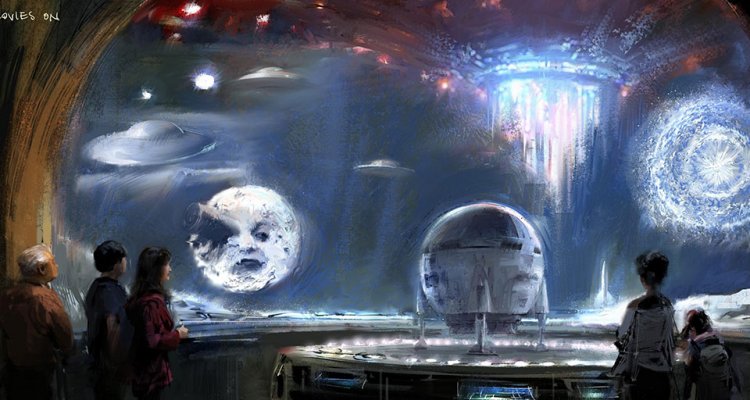It’s hard to believe, but the Academy Museum is actually almost here. The Academy of Motion Picture Arts and Sciences says the long-awaited “Oscar” museum will open in late 2019 even if construction on the site makes that seem somewhat bullish even to the untrained eye. In order to generate some much-needed positive reports on the project, AMPAS announced its inaugural slate of permanent and temporary exhibitions this afternoon.
READ MORE: Academy makes changes to mailings and more rule changes
The first long-term “permanent” exhibition will be “Where Dreams Are Made: A Journey Inside the Movies,” (working title) which will occupy two floors – 30,000 square feet, no less, – of the Museum’s iconic Saban Building—formerly known as the May Company building. This exhibition will look at the development of the art and science of motion pictures. It sounds generic and, frankly, makes a lot of sense from a consumer standpoint. The museum will need to survive on tourism and this is the sort of general exhibition they will expect.
The museum’s first temporary exhibition will focus on legendary Japanese filmmaker Hayao Miyazaki and will be a collaboration with the filmmaker’s Studio Ghibli. This will be the first major exhibition of his work presented in the United States and from an artistic perspective is historically notable. Miyazaki is the sort of artist who could have a traveling exhibition at the world’s top modern art museums. This is nothing to sneeze at even if it seems obvious at first.
Miyazaki’s exhibit will be followed in the fall of 2020, almost a year after the opening of the museum, by Regeneration: Black Cinema 1900–1970. The Academy Museum describes this exhibit as a “groundbreaking exhibition that reveals the important and under-recognized history of African-American filmmakers in the development of American cinema. It will explore African-American representation in the motion picture from its advent to just beyond the Civil Rights era.” It will also be guided by an impressive advisory panel including filmmakers Charles Burnett and Ava DuVernay as well as Michael B. Gillespie, Associate Professor, The City College of New York, Department Media Communication Arts; Shola Lynch, Curator, New York Public Library, Schomburg Center for Research in Black Culture, filmmaker, Academy member; Ron Magliozzi, Curator of Film, The Museum of Modern Art; Ellen C. Scott, Associate Professor and Head of Cinema and Media Studies, UCLA School of Theater, Film, and Television; and Jacqueline N. Stewart, Professor, The University of Chicago, Department of Cinema and Media Studies.
Additionally, the Museum’s 34-foot-high project space, the Hurd Gallery, will open with a major work by the Tokyo-based interdisciplinary art collective teamLab(can you say Instagram destination?). Other upcoming exhibitions will include “Making of: The Wizard of Oz” featuring elements that contributed to the creation of this iconic film, a “History of the Academy Awards” and, of course, an Oscars experience. All somewhat expected.
In a statement, the museum’s director Kerry Brougher noted, “We want the Academy Museum to add to the public’s understanding of the evolution of the art and science of filmmaking around the world—to increase appreciation for this great art form and encourage people to examine the role of movies in society. At the same time, we want to bring to life the most important reason of all for caring about the movies—because they’re magic. That’s why we intend to transport our visitors into a world that exists somewhere between reality and illusion. Like the experience of watching a movie, a trip to the Museum will be a kind of waking dream in which visitors feel as if they’ve slipped through the screen to see how the magic is created.”
In that press release, the Academy provided a plethora of details surrounding the aforementioned experiences. For example, the Oscar portion of the museum will allow visitors to “trace the rich history of the Academy Awards and the story of the Oscar in an exhibition that includes favorite highlights, memorable winners’ speeches, private backstage moments, and rarely seen materials from the Academy’s collection. The exhibition will look back at the show, its glamour as well as its controversies, and the ways in which the Academy Awards ceremony has evolved and been a mirror of our culture. Visitors will then enter a gallery offering an Oscars experience only the Academy can provide, allowing visitors their own photo opportunity and Oscar moment.” Yes, you too can get your photo with an Oscar statue. I mean, that was inevitable, no?
The Academy Museum has provided a plethora of details on just how the layout and spaces will work and more on that subject can be found here.
Despite concerns about the museum’s design (the globe is slightly reductive and already feels dated) and lingering concern over costs (it’s rumored to be over $100 million in the red), there should be hope that the museum is a success. As an industry, we should be rooting for it. A major movie museum in Los Angeles should have been a priority decades ago. And it’s going to take time. Rarely does a museum open up without needing a few years to find its sea legs. Moreover, balancing the museum’s artistic responsibilities with its commercial needs will be the biggest challenge if it wants to be taken seriously as a true cultural institution.
But, again, give it time. And if you happen to be in Los Angeles once it opens, maybe buy a ticket or two.


